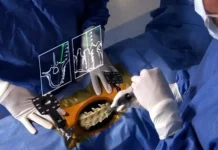NANO-X IMAGING LTD (“Nanox” or the “Company,” Nasdaq: NNOX), an innovative medical imaging technology company, announced that its deep-learning medical imaging analytics subsidiary, Nanox.AI, received FDA 510(k) clearance for HealthOST device, an AI software that provides qualitative and quantitative analysis of the spine from CT to support clinicians in the evaluation and assessment of musculoskeletal disease. Measurements of vertebral fractures and low bone density have been shown to increase the identification of patients with musculoskeletal disease of the spine, such as osteoporosis, a disease that affects more than 10 million people in the U.S.1
“AI technologies like HealthOST are poised to support routine clinical decision making and potentially improve patients’ health outcomes.”
This is Nanox.AI’s tenth FDA clearance across its innovative portfolio of AI clinical decision assist tools and second FDA clearance for its vertebral compression fracture device. HealthOST offers a more detailed evaluation, including the ability to measure fractures more precisely, potentially aiding clinicians in evaluating risk factors for osteoporosis. The company’s latest AI solution automatically identifies findings suggestive of compression fractures and low bone density, enabling further work up and treatment of patients diagnosed with osteoporosis to prevent potentially life-changing major osteoporotic fractures, such as a hip fracture. Nanox.AI previously received FDA clearance in May 2020 for the AI software that identifies vertebral compression fractures.
“With the FDA clearance of HealthOST, we are thrilled to offer radiologists a new tool that provides deeper analysis of medical images to support identifying those patients who may be at-risk of developing prevalent musculoskeletal conditions such as osteoporosis, to help promote further work up and treatment of those patients,” said Pini Ben Elazar, General Manager of Nanox.AI. “Our new product reflects our vision to create solutions to improve population health, building upon our strong track record of developing AI applications to help identify risk factors for chronic health conditions.”
According to the World Congress of Osteoporosis, 75% of compression fractures are missed or not reported. According to the CDC, approximately 10.2 million adults in the U.S. have osteoporosis while 43.3 million more have low bone density.1 Evidence suggests that there is a 25% mortality rate reported within one year of a patient sustaining a hip fracture.2
“This FDA clearance is yet another step in our commitment to delivering technologies that promote population health and value-based care,” said Erez Meltzer, Chief Executive Officer of Nanox. “AI technologies like HealthOST are poised to support routine clinical decision making and potentially improve patients’ health outcomes.”
HealthOST provides qualitative and quantitative analysis of the spine, including labelling of T1-L4 vertebrae, measurement of height loss in each vertebra (T1-L4) and measurement of the mean Hounsfield Units (HU) in volume of interest within vertebra (T11-L4). HealthOST is indicated for use in patients aged 50 and over undergoing CT scan for any clinical indication that includes at least four vertebrae in the T1-L4 portion of the spine (for vertebral height loss) and T11-L4 (for bone attenuation) portions of the spine.
Nanox.AI’s portfolio also includes HealthCCSng, an FDA-cleared AI cardiac imaging solution that quantifies coronary artery calcium (CAC), to identify patients potentially at risk for a cardiovascular event, to promote further work up and possible treatment for cardiac disease.
About Nanox
Nanox (NASDAQ: NNOX) is focused on applying its proprietary medical imaging technology and solutions to make diagnostic medicine more accessible and affordable across the globe. The vision of Nanox is to increase the early detection of medical conditions that are discoverable by medical image technologies based on X-rays, which we believe is key to increasing early prevention and treatment, improving health outcomes, and, ultimately, saving lives. We are developing a holistic imaging solution, which includes the Nanox System, comprised of the Nanox.ARC using our novel MEMs X-ray source technology, and the Nanox.CLOUD, a companion cloud software, integrated with AI solutions and teleradiology services. Our vision is to increase early detection of medical conditions that are discoverable by X-ray by improving access to imaging, reducing imaging costs, and enhancing imaging efficiency, which we believe is key to increasing early prevention treatment, improving health outcomes and ultimately saving lives. For more information, please visit www.nanox.vision.
RELATED: FDA clears four new parameters for Caretaker Medical’s wireless patient monitoring system
About Nanox.AI
Nanox.AI is the deep-learning medical imaging analytics subsidiary of Nanox. Nanox.AI solutions are developed to target highly prevalent chronic and acute diseases affecting large populations around the world. Leveraging AI, Nanox.AI helps clinicians extract valuable and actionable clinical insights from medical imaging that otherwise may go unnoticed, potentially initiating further medical assessment to establish individual preventative care pathways for patients. For more information, please visit www.nanox.vision/ai.
Forward-Looking Statements
This press release may contain forward-looking statements that are subject to risks and uncertainties. All statements that are not historical facts contained in this press release are forward-looking statements. Such statements include, but are not limited to, any statements relating to the initiation, timing, progress and results of the Company’s research and development, manufacturing and commercialization activities with respect to its X-ray source technology and the Nanox.ARC, the ability to realize the expected benefits of the acquisitions, and the projected business prospects of the Company and the acquired companies. In some cases, you can identify forward-looking statements by terminology such as “can,” “might,” “believe,” “may,” “estimate,” “continue,” “anticipate,” “intend,” “should,” “plan,” “should,” “could,” “expect,” “predict,” “potential,” or the negative of these terms or other similar expressions. Forward-looking statements are based on information the Company has when those statements are made or management’s good faith belief as of that time with respect to future events, and are subject to risks and uncertainties that could cause actual performance or results to differ materially from those expressed in or suggested by the forward-looking statements. Factors that could cause actual results to differ materially from those currently anticipated include: risks related to (1) the inability to successfully integrate the acquired companies’ business, (2) the inability to realize the anticipated benefits of the acquisitions, which may be affected by, among other things, competition, brand recognition, the ability of the acquired companies to grow and manage growth profitably and retain their key employees, (3) costs related to the acquisitions and/or unknown or inestimable liabilities, (4) changes in applicable laws or regulations that impact the operations of the acquired companies, (5) the failure to meet projected technology development targets, (6) the failure of the acquired companies to effectively scale end-to-end medical imaging solutions worldwide, (7) changes in global, political, economic, business, competitive, market and regulatory forces, and (8) (i) Nanox’s ability to successfully demonstrate the feasibility of its technology for commercial applications; (ii) Nanox’s expectations regarding collaborations with third-parties and their potential benefits; and (iii) Nanox’s ability to conduct business globally, among other things.
For a discussion of other risks and uncertainties, and other important factors, any of which could cause Nanox’s actual results to differ from those contained in the Forward-Looking Statements, see the section titled “Risk Factors” in Nanox’s Annual Report on Form 20-F for the year ended December 31, 2020 and subsequent filings with the U.S. Securities and Exchange Commission. The reader should not place undue reliance on any forward-looking statements included in this press release.
Except as required by law, Nanox undertakes no obligation to update publicly any forward-looking statements after the date of this report to conform these statements to actual results or to changes in the Company’s expectations.






